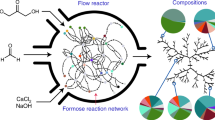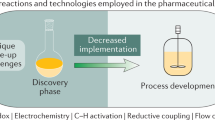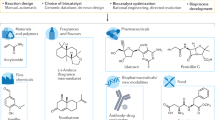Abstract
Modern-day chemical synthesis is still mainly a linear process that focuses on the design and optimization of single catalysts and reactions. By contrast, (bio)synthesis in nature is carried out by metabolic networks that are highly integrated, self-optimizing, multi-catalyst systems operating out of thermodynamic equilibrium. This allows the continuous, self-improving, multi-step synthesis of compounds from sustainable starting materials under mild and environmentally friendly conditions. While our capabilities to build catalytic systems of similar performance have been limited so far, current developments in chemistry, material sciences and synthetic biology open new paths technologically and conceptually. In this Perspective, we develop the idea that the future of catalysis is bio-inspired integrated catalytic systems that show life-like properties and provide a roadmap towards achieving this goal along five key steps: the design of biocatalysts, their combination into complex catalytic networks, the coupling of these reaction networks to energy modules, their compartmentalization and finally, their endowment with Darwinian properties.
This is a preview of subscription content, access via your institution
Access options
Access Nature and 54 other Nature Portfolio journals
Get Nature+, our best-value online-access subscription
$29.99 / 30 days
cancel any time
Subscribe to this journal
Receive 12 digital issues and online access to articles
$119.00 per year
only $9.92 per issue
Buy this article
- Purchase on Springer Link
- Instant access to full article PDF
Prices may be subject to local taxes which are calculated during checkout


Similar content being viewed by others
References
Armor, J. N. A history of industrial catalysis. Catal. Today 163, 3–9 (2011).
Seeman, J. I. The Nozoe Autograph Books: Stories behind the Stories. Chem. Rec. 13, 483–514 (2013).
Eschenmoser, A. & Wintner, C. E. Natural product synthesis and vitamin B12. Science 196, 1410–1420 (1977).
Li, K. T. et al. An effective and simplified pH-stat control strategy for the industrial fermentation of vitamin B(12) by Pseudomonas denitrificans. Bioprocess. Biosyst. Eng. 31, 605–610 (2008).
Beneyton, T. et al. Out-of-equilibrium microcompartments for the bottom-up integration of metabolic functions. Nat. Commun. 9, 2391 (2018).
Weiss, M. et al. Sequential bottom-up assembly of mechanically stabilized synthetic cells by microfluidics. Nat. Mater. 17, 89–96 (2018).
Deshpande, S. et al. Spatiotemporal control of coacervate formation within liposomes. Nat. Commun. 10, 1800 (2019).
Hasatani, K. et al. High-throughput and long-term observation of compartmentalized biochemical oscillators. ChemComm 49, 8090–8092 (2013).
Dupin, A. & Simmel, F. C. Signalling and differentiation in emulsion-based multi-compartmentalized in vitro gene circuits. Nat. Chem. 11, 32–39 (2019).
Booth, M. J., Restrepo Schild, V., Box, S. J. & Bayley, H. Light-patterning of synthetic tissues with single droplet resolution. Sci. Rep. 7, 9315 (2017).
Schwille, P. et al. MaxSynBio: avenues towards creating cells from the bottom up. Angew. Chem. Int. Ed. 57, 13382–13392 (2018).
UniProt Consortium. UniProt: a worldwide hub of protein knowledge. Nucleic Acids Res. 47, D506–D515 (2018).
Jeske, L., Placzek, S., Schomburg, I., Chang, A. & Schomburg, D. BRENDA in 2019: a European ELIXIR core data resource. Nucleic Acids Res. 47, D542–D549 (2018).
Yahya, A. R. M., Anderson, W. A. & Moo-Young, M. Ester synthesis in lipase-catalyzed reactions. Enzyme Microb. Technol. 23, 438–450 (1998).
Bornscheuer, U. T. & Kazlauskas, R. J. Catalytic promiscuity in biocatalysis: using old enzymes to form new bonds and follow new pathways. Angew. Chem. Int. Ed. 43, 6032–6040 (2004).
Glueck, S. M., Gumus, S., Fabian, W. M. F. & Faber, K. Biocatalytic carboxylation. Chem. Soc. Rev. 39, 313–328 (2010).
Martin, J., Eisoldt, L. & Skerra, A. Fixation of gaseous CO2 by reversing a decarboxylase for the biocatalytic synthesis of the essential amino acid l-methionine. Nat. Catal. 1, 555–561 (2018).
Bernhardsgrutter, I. et al. Awakening the sleeping carboxylase function of enzymes: engineering the natural CO2-binding potential of reductases. J. Am. Chem. Soc. 141, 9778–9782 (2019).
Schwander, T., Schada von Borzyskowski, L., Burgener, S., Cortina, N. S. & Erb, T. J. A synthetic pathway for the fixation of carbon dioxide in vitro. Science 354, 900–904 (2016).
Burgener, S., Schwander, T., Romero, E., Fraaije, M. W. & Erb, T. J. Molecular basis for converting (2S)-methylsuccinyl-CoA dehydrogenase into an oxidase. Molecules 23, 68 (2017).
Hammer, S. C., Knight, A. M. & Arnold, F. H. Design and evolution of enzymes for non-natural chemistry. Curr. Opin. Green Sust. 7, 23–30 (2017).
Jeschek, M., Panke, S. & Ward, T. R. Artificial metalloenzymes on the verge of new-to-nature metabolism. Trends Biotechnol. 36, 60–72 (2018).
Coelho, P. S., Brustad, E. M., Kannan, A. & Arnold, F. H. Olefin cyclopropanation via carbene transfer catalyzed by engineered cytochrome P450 enzymes. Science 339, 307–310 (2013).
Kan, S. B., Lewis, R. D., Chen, K. & Arnold, F. H. Directed evolution of cytochrome c for carbon-silicon bond formation: Bringing silicon to life. Science 354, 1048–1051 (2016).
Hammer, S. C. et al. Anti-Markovnikov alkene oxidation by metal-oxo-mediated enzyme catalysis. Science 358, 215–218 (2017).
Hammer, S. C., Marjanovic, A., Dominicus, J. M., Nestl, B. M. & Hauer, B. Squalene hopene cyclases are protonases for stereoselective Bronsted acid catalysis. Nat. Chem. Biol. 11, 121–126 (2015).
Gally, C., Nestl, B. M. & Hauer, B. Engineering Rieske non-heme iron oxygenases for the asymmetric dihydroxylation of alkenes. Angew. Chem. Int. Ed. 54, 12952–12956 (2015).
Alonso-de Castro, S., Cortajarena, A. L., López-Gallego, F. & Salassa, L. Bioorthogonal catalytic activation of platinum and ruthenium anticancer complexes by FAD and flavoproteins. Angew. Chem. Int. Ed. 57, 3143–3147 (2018).
Obexer, R. et al. Emergence of a catalytic tetrad during evolution of a highly active artificial aldolase. Nat. Chem. 9, 50–56 (2017).
Jeschek, M. et al. Directed evolution of artificial metalloenzymes for in vivo metathesis. Nature 537, 661–665 (2016).
Key, H. M., Dydio, P., Clark, D. S. & Hartwig, J. F. Abiological catalysis by artificial haem proteins containing noble metals in place of iron. Nature 534, 534–537 (2016).
Jewett, M. C., Calhoun, K. A., Voloshin, A., Wuu, J. J. & Swartz, J. R. An integrated cell-free metabolic platform for protein production and synthetic biology. Mol. Syst. Biol. 4, 220 (2008).
Hold, C., Billerbeck, S. & Panke, S. Forward design of a complex enzyme cascade reaction. Nat. Commun. 7, 12971 (2016).
Opgenorth, P. H., Korman, T. P. & Bowie, J. U. A synthetic biochemistry module for production of bio-based chemicals from glucose. Nat. Chem. Biol. 12, 393–395 (2016).
Valliere, M. A. et al. A cell-free platform for the prenylation of natural products and application to cannabinoid production. Nat. Commun. 10, 565 (2019).
Carbonell, P., Parutto, P., Baudier, C., Junot, C. & Faulon, J. L. Retropath: automated pipeline for embedded metabolic circuits. ACS Synth. Biol. 3, 565–577 (2014).
Erb, T. J., Jones, P. R. & Bar-Even, A. Synthetic metabolism: metabolic engineering meets enzyme design. Curr. Opin. Chem. Biol. 37, 56–62 (2017).
Siegel, J. B. et al. Computational protein design enables a novel one-carbon assimilation pathway. Proc. Natl Acad. Sci. USA 112, 3704–3709 (2015).
Bogorad, I. W., Lin, T. S. & Liao, J. C. Synthetic non-oxidative glycolysis enables complete carbon conservation. Nature 502, 693–697 (2013).
Sun, J., Jeffryes, J. G., Henry, C. S., Bruner, S. D. & Hanson, A. D. Metabolite damage and repair in metabolic engineering design. Metab. Eng. 44, 150–159 (2017).
Opgenorth, P. H., Korman, T. P. & Bowie, J. U. A synthetic biochemistry molecular purge valve module that maintains redox balance. Nat. Commun. 5, 4113 (2014).
Opgenorth, P. H., Korman, T. P., Iancu, L. & Bowie, J. U. A molecular rheostat maintains ATP levels to drive a synthetic biochemistry system. Nat. Chem. Biol. 13, 938–942 (2017).
Andexer, J. N. & Richter, M. Emerging enzymes for ATP regeneration in biocatalytic processes. ChemBioChem 16, 380–386 (2015).
Mordhorst, S. et al. Several polyphosphate kinase 2 enzymes catalyse the production of adenosine 5’-polyphosphates. ChemBioChem 20, 1019–1022 (2019).
Mordhorst, S., Siegrist, J., Müller, M., Richter, M. & Andexer, J. N. Catalytic alkylation using a cyclic S-adenosylmethionine regeneration system. Angew. Chem. Int. Ed. 56, 4037–4041 (2017).
Masada, S. et al. An efficient chemoenzymatic production of small molecule glucosides with in situ UDP-glucose recycling. FEBS Lett. 581, 2562–2566 (2007).
Spaans, S. K., Weusthuis, R. A., van der Oost, J. & Kengen, S. W. NADPH-generating systems in bacteria and archaea. Front. Microbiol. 6, 742 (2015).
Huang, R., Chen, H., Zhong, C., Kim, J. E. & Zhang, Y. H. High-throughput screening of coenzyme preference change of thermophilic 6-phosphogluconate dehydrogenase from NADP+ to NAD+. Sci. Rep. 6, 32644 (2016).
Megarity, C. F. et al. Electrocatalytic volleyball: rapid nanoconfined nicotinamide cycling for organic synthesis in electrode pores. Angew. Chem. Int. Ed. 58, 4948–4952 (2019).
Otrin, L. et al. Toward artificial mitochondrion: mimicking oxidative phosphorylation in polymer and hybrid membranes. Nano Lett. 17, 6816–6821 (2017).
Lee, K. Y. et al. Photosynthetic artificial organelles sustain and control ATP-dependent reactions in a protocellular system. Nat. Biotechnol. 36, 530–535 (2018).
Schmid-Dannert, C. & López-Gallego, F. Advances and opportunities for the design of self-sufficient and spatially organized cell-free biocatalytic systems. Curr. Opin. Chem. Biol. 49, 97–104 (2019).
Koga, S., Williams, D. S., Perriman, A. W. & Mann, S. Peptide–nucleotide microdroplets as a step towards a membrane-free protocell model. Nat. Chem. 3, 720–724 (2011).
Stadler, B. et al. A microreactor with thousands of subcompartments: enzyme-loaded liposomes within polymer capsules. Angew. Chem. Int. Ed. 48, 4359–4362 (2009).
Weiss, M. et al. Sequential bottom-up assembly of mechanically stabilized synthetic cells by microfluidics. Nat. Mater. 17, 89–96 (2018).
Jo, S.-M., Wurm, F. R. & Landfester, K. Biomimetic cascade network between interactive multicompartments organized by enzyme-loaded silica nanoreactors. ACS Appl. Mater. Interfaces 10, 34230–34237 (2018).
Ferlez, B., Sutter, M. & Kerfeld, C. A. A designed bacterial microcompartment shell with tunable composition and precision cargo loading. Metab. Eng. 54, 286–291 (2019).
Noireaux, V. & Libchaber, A. A vesicle bioreactor as a step toward an artificial cell assembly. Proc. Natl Acad. Sci. USA 101, 17669–17674 (2004).
Karim, A. S. & Jewett, M. C. A cell-free framework for rapid biosynthetic pathway prototyping and enzyme discovery. Metab. Eng. 36, 116–126 (2016).
Atsumi, S., Hanai, T. & Liao, J. C. Non-fermentative pathways for synthesis of branched-chain higher alcohols as biofuels. Nature 451, 86–89 (2008).
Dellomonaco, C., Clomburg, J. M., Miller, E. N. & Gonzalez, R. Engineered reversal of the beta-oxidation cycle for the synthesis of fuels and chemicals. Nature 476, 355–359 (2011).
Yim, H. et al. Metabolic engineering of Escherichia coli for direct production of 1,4-butanediol. Nat. Chem. Biol. 7, 445–452 (2011).
Clomburg, J. M., Qian, S., Tan, Z., Cheong, S. & Gonzalez, R. The isoprenoid alcohol pathway, a synthetic route for isoprenoid biosynthesis. Proc. Natl Acad. Sci. USA 116, 12810–12815 (2019).
Antonovsky, N. et al. Sugar synthesis from CO2 in Escherichia coli. Cell 166, 115–125 (2016).
Schada von Borzyskowski, L. et al. An engineered Calvin–Benson–Bassham cycle for carbon dioxide fixation in Methylobacterium extorquens AM1. Metab. Eng. 47, 423–433 (2018).
Lin, P. P. et al. Construction and evolution of an Escherichia coli strain relying on nonoxidative glycolysis for sugar catabolism. Proc. Natl Acad. Sci. USA 115, 3538–3546 (2018).
Bernhardsgrutter, I. et al. The multicatalytic compartment of propionyl-CoA synthase sequesters a toxic metabolite. Nat. Chem. Biol. 14, 1127–1132 (2018).
Hyde, C. C., Ahmed, S. A., Padlan, E. A., Miles, E. W. & Davies, D. R. Three-dimensional structure of the tryptophan synthase alpha 2 beta 2 multienzyme complex from Salmonella typhimurium. J. Biol. Chem. 263, 17857–17871 (1988).
Ferreira, R. D. G., Azzoni, A. R. & Freitas, S. Techno-economic analysis of the industrial production of a low-cost enzyme using E. coli: the case of recombinant beta-glucosidase. Biotechnol. Biofuels 11, 81 (2018).
Korman, T. P., Opgenorth, P. H. & Bowie, J. U. A synthetic biochemistry platform for cell free production of monoterpenes from glucose. Nat. Commun. 8, 15526 (2017).
Taylor, H. S. Catalysis in chemical industry. Nature 104, 94–95 (1919).
Tamura, J. et al. Electrochemical reduction of CO2 to ethylene glycol on imidazolium ion-terminated self-assembly monolayer-modified Au electrodes in an aqueous solution. Phys. Chem. Chem. Phys. 17, 26072–26078 (2015).
Kalberer, P. P., Buchanan, B. B. & Arnon, D. I. Rates of photosynthesis by isolated chloroplasts. Proc. Natl Acad. Sci. USA 57, 1542–1549 (1967).
Nickel, H. Gewicht und Zusammensetzung der Chloroplasten von Antirrhinum majus. Flora Abt. A 159, 233–252 (1968).
Acknowledgements
This work was supported by the MaxSynBio network, jointly funded by the Federal Ministry of Education and Research (BMBF) and the Max Planck Society, the European Research Council (Grant No. 637675 SYBORG), The European Coordination and Support Action on biological standardization BIOROBOOST and the International Max Planck Research School for Environmental, Molecular and Cellular Microbiology.
Author information
Authors and Affiliations
Contributions
The manuscript was written with contributions of all authors, in particular S.B. (enzyme design), R.M. and T.E.M. (complex networks and cofactor regeneration), S.L. (Darwinian systems) and T.J.E. (all paragraphs, including introduction and conclusion).
Corresponding author
Ethics declarations
Competing interests
The authors declare no competing interests.
Additional information
Publisher’s note Springer Nature remains neutral with regard to jurisdictional claims in published maps and institutional affiliations.
Rights and permissions
About this article
Cite this article
Burgener, S., Luo, S., McLean, R. et al. A roadmap towards integrated catalytic systems of the future. Nat Catal 3, 186–192 (2020). https://doi.org/10.1038/s41929-020-0429-x
Received:
Accepted:
Published:
Issue Date:
DOI: https://doi.org/10.1038/s41929-020-0429-x
This article is cited by
-
Iterative design of training data to control intricate enzymatic reaction networks
Nature Communications (2024)
-
Frustrations of supported catalytic clusters under operando conditions predicted by a simple lattice model
Scientific Reports (2022)
-
A host–guest semibiological photosynthesis system coupling artificial and natural enzymes for solar alcohol splitting
Nature Communications (2021)



